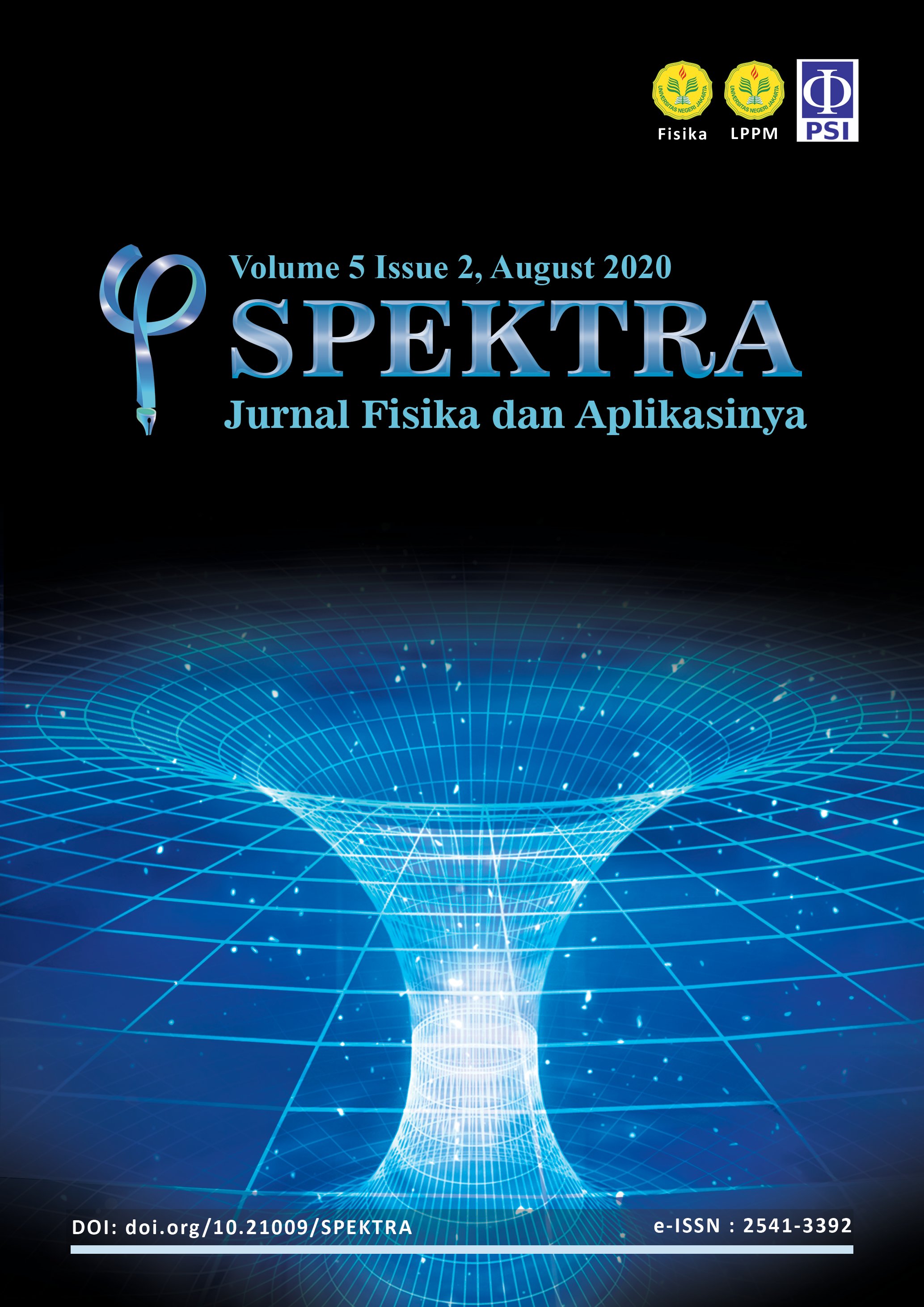THE MAGNETIC PROPERTIES MEASUREMENT OF COIL FOR GRAVITATIONAL ACCELERATION DETERMINATION
DOI:
https://doi.org/10.21009/SPEKTRA.052.04Keywords:
graphic method, gravity acceleration, current balanceAbstract
The value of the gravitational acceleration of the earth above the earth’s surface depends on the position of the latitude and longitude of the earth’s surface, in other words, because the shape of the earth’s surface is not round like a ball. The magnitude of gravity is not the same everywhere on the surface of the earth. The purpose of this study is to analyze the value of the earth’s gravitational acceleration in a laboratory using a current balance with a graphical method. Fluctuations in the value of the magnetic field strength (B) and the value of the electric current strength (i) on the current balance cause the value of laboratory gravitational acceleration (glab) to vary in the transfer of electric charge (q) according to coil type. The magnitude of the earth’s gravitational acceleration value obtained in a laboratory with a current balance for each type of coil is as follows: SF-37 glab-nr=9.89 m/s2, SF-38 glab-nr=9.90 m/s2, SF-39 glab-nr=9.76 m/s2, SF-40 glab-nr=9.95 m/s2, SF-41 glab-nr=9.75 m/s2 dan SF-42 glab-nr=9.93 m/s2. The results obtained indicate that the value of the earth’s gravitational acceleration in a laboratory close to the literature value is the value of the glab-nr in the SF-37 coil type of 9.89 m/s2.
References
[2] Q. Wang et al “A New Method of Measuring Gravitational Acceleration in an Undergraduate Laboratory Program,” European Journal of Physics, 2018, vol. 39.
[3] N. Suwanpayak et al., “A Comparison of Gravitational Acceleration Measurement Methods for Undergraduate Experiment,” Journal of Physics: Conference Series, 2018, vol. 1144.
[4] D. A. I. Astuti, “Pengembangan Alat Eksperimen Penentuan Percepatan Gravitasi Bumi Berdasarkan Teori Bidang Miring Berbasis Microcomputer Based Laboratoy (MBL),” Faktor Exacta, 2016, vol. 9.
[5] S. Ilmi, U. Harmoko and S. Widada, “Interpretasi Bawah Permukaan Sistem Panas Bumi Diwak dan Derekan Berdasarkan Data Gravitasi,” Youngster Physics Journal, 2014, vol. 3.
[6] L. Lombriser and N. A. Lima, “Challenges to Self-Acceleration in Modified Gravity from Gravitational Waves and Large-Scale Structure,” Physics Letters B, 2017. vol. 765.
[7] Y. Zhu, “Gravitational Magnetic Electric Field Interaction,” Results in Physics, 2018, vol. 10.
[8] A. A. Gonfalone, “Sleep and Gravity,” Medical Hypotheses, 2018, vol. 113.
[9] W. Hayt and J. Buck (Terjemahan Irzam. Harmein), “Elektromagnetika,” Erlangga, Jakarta, 2006.
[10] P. A. Tipler, “Fisika Untuk Sains dan Teknik Jilid 2,” Erlangga, Jakarta, 1996.
[11] D. Halliday and R. Resnick (Terjemahan Pantur Silaban), “Fisika Dasar Untuk Universitas Jilid 2,” Erlangga, Jakarta, 1984.
Downloads
Published
How to Cite
Issue
Section
License
SPEKTRA: Jurnal Fisika dan Aplikasinya allow the author(s) to hold the copyright without restrictions and allow the author(s) to retain publishing rights without restrictions. SPEKTRA: Jurnal Fisika dan Aplikasinya CC-BY or an equivalent license as the optimal license for the publication, distribution, use, and reuse of scholarly work. In developing strategy and setting priorities, SPEKTRA: Jurnal Fisika dan Aplikasinya recognize that free access is better than priced access, libre access is better than free access, and libre under CC-BY or the equivalent is better than libre under more restrictive open licenses. We should achieve what we can when we can. We should not delay achieving free in order to achieve libre, and we should not stop with free when we can achieve libre.
 SPEKTRA: Jurnal Fisika dan Aplikasinya is licensed under a Creative Commons Attribution 4.0 International License.
SPEKTRA: Jurnal Fisika dan Aplikasinya is licensed under a Creative Commons Attribution 4.0 International License.
You are free to:
Share - copy and redistribute the material in any medium or format
Adapt - remix, transform, and build upon the material for any purpose, even commercially.
The licensor cannot revoke these freedoms as long as you follow the license terms.

 E-ISSN 2541-3392
E-ISSN 2541-3392  Focus & Scope
Focus & Scope  Editorial Team
Editorial Team  Reviewer Team
Reviewer Team  Author Guidelines
Author Guidelines  Article Template
Article Template  Author Fee
Author Fee  Publication Ethics
Publication Ethics  Plagiarism Policy
Plagiarism Policy  Open Access Policy
Open Access Policy  Peer Review Process
Peer Review Process  Retraction & Correction
Retraction & Correction  Licensing & Copyright
Licensing & Copyright  Archiving & Repository
Archiving & Repository  Contact
Contact  Mendeley
Mendeley 

